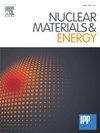Modified sink strength model for dislocation in tungsten: Dependence on temperature and probability density distribution
IF 2.7
2区 物理与天体物理
Q1 NUCLEAR SCIENCE & TECHNOLOGY
引用次数: 0
Abstract
Sink strength, as a fundamental parameter in mean-field approaches, describes the ability of sinks (e.g., dislocation lines) to capture migrating defects and is crucial for simulating the microstructure evolution of irradiation damage in nuclear materials. Here, taking body centered cubic tungsten (W) as an example, we systematically investigate the sink strength of dislocation lines using the object Kinetic Monte Carlo (OKMC) method. It is found that there are noteworthy discrepancies of sink strength between the traditional theoretical expression and OKMC simulations. This should be attributed to two factors, namely temperature and probability density distribution. The former can be derived from a master curve that has already been proposed for 1D to 3D diffusion–reaction kinetics, while the latter can be well described by a modified analytical expression of sink strength for dislocation lines. By incorporating these factors, the discrepancy between theoretical results and OKMC simulations is eliminated. Notably, the results of defect evolution in irradiated W, obtained using the modified sink strength expression, exhibit a greater consistency with experimental observations than those derived from the conventional model. These results provide a better insight into the sink strength model, and have broad implications for understanding and reproducing the microstructure evolution of irradiation defects in materials.
钨中位错的修正沉降强度模型:对温度和概率密度分布的依赖
沉降强度作为平均场方法中的一个基本参数,描述了沉降(例如位错线)捕获迁移缺陷的能力,对于模拟核材料辐照损伤的微观结构演变至关重要。本文以体心立方钨(W)为例,采用物体动力学蒙特卡罗(OKMC)方法系统地研究了位错线的沉降强度。研究发现,传统的理论表达式与OKMC模拟结果存在显著差异。这应归因于两个因素,即温度和概率密度分布。前者可以从已经提出的一维到三维扩散反应动力学的主曲线中推导出来,而后者可以用位错线下沉强度的修正解析表达式来很好地描述。通过结合这些因素,消除了理论结果与OKMC模拟之间的差异。值得注意的是,与传统模型相比,使用改进的汇强度表达式得到的辐照W的缺陷演化结果与实验观测结果具有更大的一致性。这些结果提供了更好地了解汇强度模型,并对理解和再现材料中辐照缺陷的微观结构演变具有广泛的意义。
本文章由计算机程序翻译,如有差异,请以英文原文为准。
求助全文
约1分钟内获得全文
求助全文
来源期刊

Nuclear Materials and Energy
Materials Science-Materials Science (miscellaneous)
CiteScore
3.70
自引率
15.40%
发文量
175
审稿时长
20 weeks
期刊介绍:
The open-access journal Nuclear Materials and Energy is devoted to the growing field of research for material application in the production of nuclear energy. Nuclear Materials and Energy publishes original research articles of up to 6 pages in length.
 求助内容:
求助内容: 应助结果提醒方式:
应助结果提醒方式:


